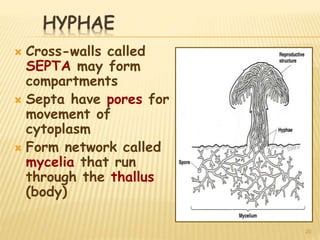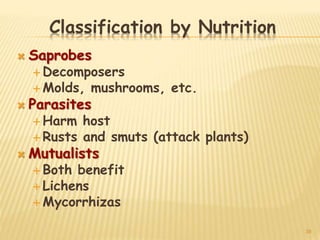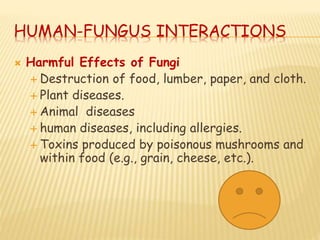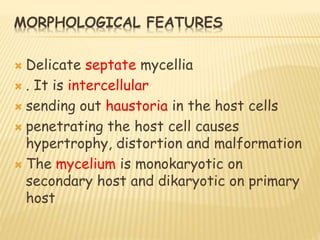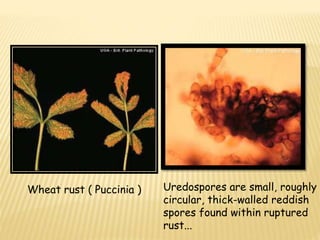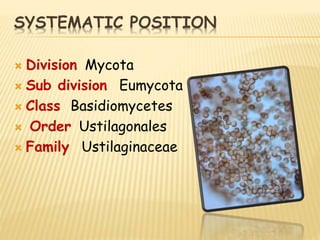Fungi
- 2. FUNGI
- 3. WE WILL LEARN General characteristics of fungi Structure of fungi Economic Importance Pathogenicity Brief intro of some fungi
- 4. THE SIX KINGDOMS Fungi are placed in a separate kingdom called the kingdom fungi
- 6. THE CHARACTERISTICS OF FUNGI Fungi are NOT plants Nonphotosynthetic Eukaryotes Nonmotile Most are saprobes (live on dead organisms) 6
- 7. THE CHARACTERISTICS OF FUNGI Absorptive heterotrophs (digest food first & then absorb it into their bodies Release digestive enzymes to break down organic material or their host Store food energy as glycogen 7 BREAD MOLD
- 8. THE CHARACTERISTICS OF FUNGI Important decomposers & recyclers of nutrients in the environment Most are multicellular, except unicellular yeast Lack true roots, stems or leaves 8 MULTICELLULAR MUSHROOM UNICELLULAR YEAST
- 9. FUNGI AS A DECOMPOSERS
- 10. THE CHARACTERISTICS OF FUNGI Cell walls are made of chitin (complex polysaccharide) Body is called the Thallus Grow as microscopic tubes or filaments called hyphae 10
- 11. THE CHARACTERISTICS OF FUNGI Some fungi are internal or external parasites A few fungi act like predators & capture prey like roundworms 11 Predaceous Fungi feeding on a Nematode (roundworm)
- 12. THE CHARACTERISTICS OF FUNGI Some are edible, while others are poisonous 12 EDIBLE POISONOUS
- 13. THE CHARACTERISTICS OF FUNGI Produce both sexual and asexual spores Classified by their sexual reproductive structures 13 Spores come in various shapes
- 14. THE CHARACTERISTICS OF FUNGI Grow best in warm, moist environments Mycology is the study of fungi Mycologists study fungi A fungicide is a chemical used to kill fungi 14 Fungicide kills leaf fungus
- 15. THE CHARACTERISTICS OF FUNGI Fungi include puffballs, yeasts, mushrooms, toadstools, rusts, smuts, ringworm, and molds The antibiotic penicillin is made by the Penicillium mold 15 Penicillium mold Puffball
- 16. FUNGI SIZE
- 18. HYPHAE 18 Tubular shape ONE continuous cell Filled with cytoplasm & nuclei Multinucleate Hard cell wall of chitin also in insect exoskeletons
- 19. HYPHAE Stolons – horizontal hyphae that connect groups of hyphae to each other Rhizoids – rootlike parts of hyphae that anchor the fungus 19 STOLON RHIZOIDS
- 20. HYPHAE Cross-walls called SEPTA may form compartments Septa have pores for movement of cytoplasm Form network called mycelia that run through the thallus (body) 20
- 21. ABSORPTIVE HETEROTROPH Fungi get carbon from organic sources Tips of Hyphae release enzymes Enzymatic breakdown of substrate Products diffuse back into hyphae Digested material is then used by the hypha Nucleus “directs” the digestive process
- 22. MODIFICATIONS OF HYPHAE Fungi may be classified based on cell division (with or without cytokinesis) Aseptate or coenocytic (without septa) Septate (with septa) 22 NO CROSS WALLS CROSS WALLS
- 23. MODIFICATIONS OF HYPHAE 23 HAUSTORIA – parasitic hyphae on plants & animals Septate Hyphae Coenocytic Hyphae
- 24. HYPHAL GROWTH Hyphae grow from their tips Mycelium is an extensive, feeding web of hyphae Mycelia are the ecologically active bodies of fungi 24 This wall is rigid Only the tip wall is plastic and stretches
- 25. REPRODUCTIVE STRUCTURES 25 ASEXUAL & SEXUAL SPORES
- 26. REPRODUCTION Most fungi reproduce Asexually and Sexually by spores ASEXUAL reproduction is most common method & produces genetically identical organisms Fungi reproduce SEXUALLY when conditions are poor & nutrients scarce 26
- 27. SPORES Spores are an adaptation to life on land Ensure that the species will disperse to new locations Each spore contains a reproductive cell that forms a new organism Nonmotile Dispersed by wind 27
- 28. HYPHAL GROWTH FROM SPORE 28 Mycelia have a huge surface area More surface area aids digestion & absorption of food mycelium Germinating spore
- 29. GENERALIZED LIFE CYCLE OF A FUNGUS
- 31. SEXUAL REPRODUCTION Used when environmental conditions are poor (lack of nutrients, space, moisture…) No male or female fungi Some fungi show dimorphism May grow as MYCELIA or a YEAST –LIKE state (Filament at 25oC & Round at 37oC) 31 Dimorphic Fungi
- 32. SEXUAL REPRODUCTION Haploid 1n hyphae from 2 mating types (+ and -) FUSE (Fertilization) Forms a hyphae with 2 nuclei that becomes a ZYGOTE The zygote divides to make a SPORE 32 + - SPORE FORMS
- 34. THREE TYPES OF ASEXUAL REPRODUCTION Fragmentation – part of the mycelium becomes separated & begins a life of its own Budding – a small cell forms & gets pinched off as it grows to full size Used by yeasts Asexual spores – production of spores by a single mycelium 34
- 35. REPRODUCE BY SPORES Spores may be Formed: Directly on hyphae Inside sporangia On Fruiting bodies Amanita fruiting body Pilobolus sporangia Penicillium hyphae
- 36. ASEXUAL REPRODUCTION Fruiting Bodies are modified hyphae that make asexual spores An upright stalk called the Sporangiosphore supports the spore case or Sporangium 36
- 37. Major Groups of Fungi 37
- 38. MAJOR GROUPS OF FUNGI Within the past few years, several groups have been re-classified into the protists Two of these groups are the slime molds and water molds
- 39. Classification by Nutrition Saprobes Decomposers Molds, mushrooms, etc. Parasites Harm host Rusts and smuts (attack plants) Mutualists Both benefit Lichens Mycorrhizas 39
- 40. MAJOR GROUPS OF FUNGI Basidiomycota – Club Fungi Zygomycota – Bread Molds Chytridiomycota – Chytrids AM Fungi - Mycorrhizas Ascomycota – Sac Fungi Lichens – Symbiosis (algae & Fungi)
- 41. ASCOMYCOTA CHYTRIDIOMYCOTA Major Groups of Fungi
- 42. BASIDIOMYCOTA ZYGOMYCOTA 42 Major Groups of Fungi
- 43. MAJOR GROUPS OF FUNGI MYCORRHIZA Lichens 43
- 44. HUMAN-FUNGUS INTERACTIONS Beneficial Effects of Fungi Decomposition - nutrient and carbon recycling. Biosynthetic factories. Can be used to produce drugs, antibiotics, alcohol, acids, food (e.g., fermented products, mushrooms). Model organisms for biochemical and genetic studies. Production of vitamin Hormone production Edible fungi Production of insecticides
- 45. FUNGI FORM BENEFICIAL PARTNERSHIPS (SYMBIOSIS) WITH OTHER ORGANISMS SUCH AS TREES AND FLOWERING PLANTS: Lichen – symbiotic relationship between algae and fungi Algae hyphae
- 46. HUMAN-FUNGUS INTERACTIONS Harmful Effects of Fungi Destruction of food, lumber, paper, and cloth. Plant diseases. Animal diseases human diseases, including allergies. Toxins produced by poisonous mushrooms and within food (e.g., grain, cheese, etc.).
- 47. Fungi as Parasites & Pathogens
- 48. SOME EXAMPLES OF FUNGI ARE . Puccunia penicillium Phythophtora ustilago
- 49. PUCCINIA ..
- 50. PUCCINIA Systematic Position Division : Mycota (Basidiomycota) Subdivision: Eumycota Class: Basidiomycetes Order: Uredinales Family: pucciniacea
- 51. HABIT AND HABITAT Puccinia are generally known as rust fungi. 700 species They are parasites on plants(wheat, coffee, beans etc). It is an internal obligate parasite. They are generally heteroecious, i.e requiring two hosts to complete life cycle.
- 52. MORPHOLOGICAL FEATURES Delicate septate mycellia . It is intercellular sending out haustoria in the host cells penetrating the host cell causes hypertrophy, distortion and malformation The mycelium is monokaryotic on secondary host and dikaryotic on primary host
- 53. ,
- 54. HAUSTORIA
- 55. REPRODUCTION life cycle on two different hosts. The diplophase (2n) stage is a parasite on wheat while the haplophase (1n) stage on an alternate host which is Barberry vulgaris. We’ll take example of Puccin graminisia
- 56. LIFE CYCLE Its life cycle spreads over five stages, which are a.Uredinial stage:- b.Telial stage:- c.Basidial stage:- d.Spermogonial stage or pycnidial stage:- e.Aecial or Aecidial stage:-
- 58. A.UREDINIAL STAGE:- first or rust stage. appear on culms, The pustule is called a Uredinium, which on maturity bursts and releases uredospores. Each uredospore is a binucleate Lying together -red-rust like appearance readily germinate on wheat plant
- 59. Wheat rust ( Puccinia ) Uredospores are small, roughly circular, thick-walled reddish spores found within ruptured rust...
- 60. B.TELIAL STAGE:- dark brown or black pustules occur in the form of streaks called telia Containing teliospores or teleutospores (dark brown ) diploid nucleus
- 62. C.BASIDIAL STAGE:- , nuclear fusion a row of four haploid nucleus. This four celled structure is called a promycelium or epibasidium Tube formation…-basidiospore Formation of spores each spore is either of + or – strain Basidiospore detach… now ready to infect
- 63. D.SPERMOGONIAL STAGE OR PYCNIDIAL STAGE:- basidiospores germinate . to attack barberry leaves mycelia spreads ( huastoria) barberry protoplasm ( their only food ) Monokaryotic mycellium (+ or – strain ) Afterfour days 2 structure formed 1.Pycnia or spermogonia on upper surface 2.Aedia or cluster cups on ventral surface
- 64. E.AECIAL OR AECIDIAL STAGE:- Aecia, aecidia or cluster cups are produced as little yellow cups on ventral surface of barberry leaf.
- 65. AECIAL OR AECIDIAL STAGE Spermatization Formation of aecidiospores. These are binucleate and brightly yellow coloured and they germinate on wheat blown by wind having six germ pores Entering in host through stomata Life cycle continues
- 66. ECONOMIC IMPORTANCE:- Puccinina graminis tritici causes black or stem rust, P. recondita causes brown or orange leaf rust P.coronata brown rust of wheat P. sorghi causes leaf rust of corn
- 68. USTILAGO
- 69. SYSTEMATIC POSITION Division Mycota Sub division Eumycota Class Basidiomycetes Order Ustilagonales Family Ustilaginaceae
- 70. HABIT AND HABITAT: 400 species internal parasites of plants Causing diseases called smuts because of black coloured spores.
- 71. VEGETATIVE STRUCTURE: mycelium may be primary or secondary. Primary mycelium is uninucleate and is called monokaryotic mycelium. Secondary mycelium is septate, dikaryotic and spreads throughout interior of the host plant Firstly intracellular and later on becomes intercellular. Mycelluim sending huastoria into the host infection appearance in flowering stage (loose smut ) , dark brown powder, ( easily blown by wind ) And host destroyed
- 72. REPRODUCTION: Chlamydospore formation mycellium accumulation Division and redivision Hyphae swelling brandspores, smut spores or chlamydospores, formation ( the black spores ) beaded appearance to the hyphae. This rusty mass or group of black spores is called the smut
- 73. Hyphae swelling
- 74. CHLAMYDOSPORE rounded or oval in shape covered by a two layered wall outer thick layer called exospore an inner delicate and smoothn layer called endosperm. after dispersal fall on soil and lead a saprophytic life basisiospore or a sporidium formation Germination .after germination basidiospores are capable of infecting
- 75. CHLAMYDOSPORE
- 78. ECONOMIC IMPORTANCE: 1.Loose smut of wheat is caused by Ustilago tritici and is a common disease
- 79. ECONOMIC IMPORTANCE: 2.it causes about 1% damage in the planes and around 10-20% in foot hills and humid places of Pakistan. 3. Covered smut of barley is caused by U.hordei and U.nuda.
- 80. ECONOMIC IMPORTANCE: 4. Loose smut of maize is caused by U.maydis or U.zeae
- 81. ECONOMIC IMPORTANCE: 5. sugar cane is attacked by U.scitaminea or U.sacchari and U.avenae cause loose smut of oat.



















